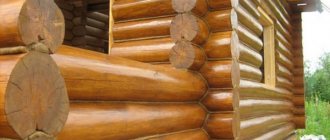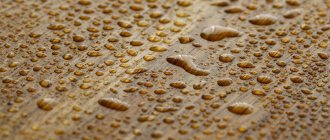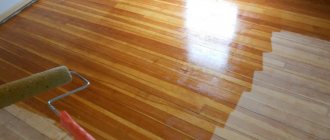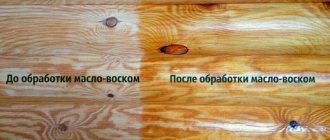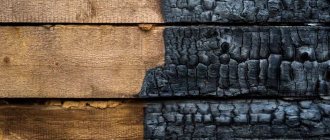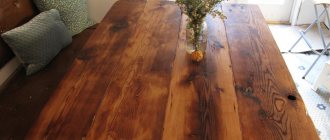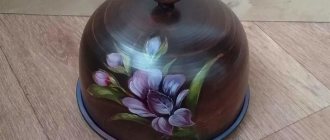Wood has many advantages, but it also has disadvantages. This is sensitivity to a humid environment. Upon contact with liquid, untreated wood fibers swell and deform, and with prolonged exposure they begin to rot. Is it possible to avoid this? Yes, and wood wax oil is used for this.
We are talking about a composition that is either sold ready-made or made with your own hands. The second option is preferable for those who are not afraid of experiments and would like to try different ways of processing wooden surfaces.
What are the benefits of waxing wood?
Treating wood with wax creates a thin protective film on the surface and, at the same time, penetrates deeply into the pores of the wood, enhancing its protection. Along with the above, the wax does not clog the pores and the wood continues to “breathe”.
Any type of wood can be treated with wax.
The only drawback of treating wood with wax is that it cannot be used in rooms with high temperatures. Because when heated, the wax begins to melt and flow out. This is where the disadvantages of waxing wood end.
Let's move on to the advantages of waxing, which are much more numerous than the disadvantages.
Wax impregnation increases the water-repellent properties of wood
Waxing wood improves the appearance, highlights the wood structure and adds shine. If you add coloring agents to the composition, you can adjust the shade of the wood.
Waxing protects the wood from cracking, damage by pests and fungi. Protects against scratches and other damage.
By the way: Wax-based impregnation can remove existing scratches on wood. You need to select a composition that matches the color and rub it on the area with the defect. The scratch will become almost invisible to the eye.
Advantages and disadvantages of the waxing procedure
Such a coating has a number of undeniable advantages:
- Protection against water ingress;
- The tree does not stop breathing;
- Protects against fungi, mold, dust and dirt;
- The surface becomes less susceptible to scratches;
- Universal, suitable for different types of arrays;
- It is possible to choose a different color palette;
- Wax does not produce toxins and is safe to use and continue to use the wax-coated product;
- Allows you to protect the surface for a long time, while the appearance of the product does not lose its beauty;
- The tree retains a pleasant smell.
Very often barrels are treated with the composition. This allows you to preserve both containers and drinks without losing their quantity and quality.
There is only one drawback worth noting. This is because wax makes wood melt more easily. Also, if alcohol gets in contact with the treated material, stains may remain.
As a rule, this treatment is not suitable for kitchen work surfaces, as well as for those places with frequent contact, for example, armrests of furniture. The effect will be too short-lived, you will have to carry out the procedure often.
Wood waxing technology
- The first step is to clean the surface of the old coating, if there was any. Clean with solvent and allow to dry
- Next, the surface is sanded in order to remove all irregularities and roughness.
- Next, wax is applied. Before applying wax, you can saturate the wood with oil. This will enhance the protective properties of the wax.
- If the wax is hard, you need to heat it in a water bath; if you purchased ready-made wax for processing, you do not need to heat it additionally.
- To apply wax, you need to use a cloth that does not have lint. The wax is rubbed into the surface with a cloth until the fabric stops sticking to the surface. Cloth is used to treat smooth surfaces. To process the ends and shaped elements, use a brush.
- After finishing the treatment, you need to leave the surface alone for several hours so that the wax is absorbed into the pores of the wood. After time, the excess is removed with a soft cloth. After this, the surface is sanded.
- If you need to add shine, then apply another thin layer of wax.
Waxing compounds are sold in stores in a huge assortment. But if you want the composition to not have any unnecessary chemical inclusions, then you can make the composition yourself. And it will cost much less.
Impregnation for baths based on wax
When they talk about “oil for a steam room in a bath,” they mean impregnation for wood, but not drying oil. Compositions have long been developed that do not smell like drying oil. In particular, there is no smell from paraffin oil. Treatment of the bathhouse inside the steam room with oils is usually limited to covering the shelves with them. This is done because it is the safest way for humans to protect the tree.
On sale you can find both liquid oil compositions and more solid varieties containing, in addition to oil, also beeswax. The latter are even better, considering that wood has been waxed for a long time, and not only for a beautiful shine, but also to increase its service life and protect it from all kinds of pests.
Protects wooden elements of baths and saunas from exposure to moisture. It gives the wood softness and velvety. To achieve a good effect, you need to apply it to the surface at least 2 times, paying more attention to the ceiling in the bathhouse, since it is the ceiling that is most exposed to moisture and usually deteriorates faster than other elements of these structures.
Heat-resistant, water- and dirt-repellent tinted decorative and protective coating based on linseed oil and carnauba wax
Oil for baths and saunas Martyanov
Heat-resistant, water- and dirt-repellent, tintable decorative and protective coating based on linseed oil and carnauba wax. Preserves the natural surface of the wood and makes it resistant to grease and gentle cleaning agents. Protects against moisture, rot, all types of fungi and mold. The protection period of the treated surface is up to 5 years (subject to application technology).
DIY waxing composition
The recipe for preparing the composition is simple.
You need turpentine, wax, rosin.
In proportions: 100 g wax, 50 g turpentine, 20-25 g rosin
The wax is melted, turpentine is added, and mixed thoroughly. Next, add rosin and mix thoroughly. Remove from heat and pour into a tin jar.
Wax, mastic, oil are traditional materials used by our workshop in the restoration of antique furniture.
During restoration, waxing wood, polishing furniture, impregnating wood with oil, mixtures of wax with turpentine, rosin, and other resins, make it possible to emphasize the beauty, color, and texture of valuable large-porous species of oak, ash, and chestnut. The waxing composition can be purchased ready-made, or you can make it yourself from beeswax, purified turpentine (pinene), and rosin.
Waxing is one of the ways to polish furniture. Its advantages include:
1. Always a quick positive effect.
2. Easy to apply.
3. To apply furniture wax to wood, no special skills are required, as when working with shellac polishes.
4. Modern wax mastics are convenient, safe, enriched with pleasant fragrances with the smell of bee honey, pine forest, lemon, floral aromas, and freshness.
5. The ability to quickly, without special skills, give a damaged antique varnish coating an expositional state.
Disadvantages include:
1. Wax on furniture made of natural wood is constantly absorbed by porous wood, or quickly wears off when touched. The polish becomes dull. Things require careful care and constant updating. Especially tabletops, protruding decorative overlays, facades, carvings.
Waxing furniture in restoration
Waxing is carried out in cases where the item was originally designed specifically for wax finishing. Impregnation of wood with wax and oil for furniture is determined by the type, style, and time of execution of the exhibit. Waxing furniture is the simplest inexpensive polish. It is convenient to compare prices for various finishes using the price list (see the end of the article).
Using thick mastic, a quick visual effect is obtained during pre-sale preparation. This is something that sellers of European interior items actively use: cabinets, sideboards, tables, tables, chests of drawers, thereby making the upcoming complete restoration more expensive by complicating future cleaning.
In order to obtain the desired shade of furniture, mastics are tinted with pigments. Their cost ranges from 100 rubles to several thousand for the same amount of the drug. This is explained by the different quality of the product (beeswax or its substitutes), brand, and method of sale.
Only the spread of polishing with shellac polish, caused by the fashion for mahogany, reduced the scope of waxing. Since the 19th century, furniture makers, almost everywhere, switched to shellac varnishing.
Turpentine, wax, rosin - components of waxing mastic
The basis of any mastic for the restoration of wooden furniture is three components. Solvent, filler, shine former. The main components of mastic for wood furniture are turpentine, wax, and rosin. The amount of turpentine regulates the thickness. The presence of rosin adds shine, shine, and durability.
WAX
is a series of substances that are similar in properties to beeswax. In terms of chemical composition, it is an ester of fatty acids and simple monobasic alcohols.
BEE WAX
the most common, known to everyone. It is obtained from the honeycombs that bees fill with their honey. There are two types: yellow (raw), white (refined). Raw is usually yellow in color, varying in intensity. Has a pleasant honey smell. Purified by melting in water and bleached by the sun or chemicals, it is white in delicate shades. It is often adulterated with stearin, ceresin, lard, etc. The bee product is used for the production of polishes, varnishes, dressings (composition for finishing leather), mastic for rubbing floors, sealing wax, etc.
CARNAUBA WAX
stands out on the surface of the leaves of a special type of palm tree from the tropical regions of America. Especially common in Brazil. There are several varieties. The highest grades are light yellow, almost white, brittle, soluble in ether. Slightly soluble in cold alcohol. It is used for the manufacture of finishing materials, candle production, shoe polishes, and cosmetics.
SHELLAC WAX
obtained by preparing bleached shellac. It is widely used to this day as a by-product in the production of varnishes. It has colors from light yellow to chocolate. It is used for making shoe polishes and gives a good gloss. Neither water nor cold alcohol is its solvent.
JAPANESE WAX
called “wax” conventionally. This is a fat of vegetable origin, extracted from the pulp, seeds, stems, Japanese, Chinese, Korean oilseeds. Dissolves in hot alcohol, ether, gasoline. It is used in the production of finishing materials, care products for furniture, shoes, and cosmetics.
OZOKERITE AND CERESIN
(earth or rock wax) a product of the natural loss of most volatile substances from oil, fossil paraffin, which differs from factory-produced paraffin in its amorphous structure. Ozokerite and ceresin obtained from it by purification have found wide application in the production of polishing mastics for waxing, shoe polishes, and cosmetics. Well-purified ceresin is white or yellow in color.
PARAFFIN
obtained mainly from petroleum. Purified paraffin is white, tasteless, odorless, greasy to the touch. Varieties differ in melting point. For cosmetic purposes, a low-melting one is used (melting point 38-40 degrees), for technical purposes a more refractory one (52-62 degrees). Paraffin is widely used for making candles, in match production, making transparent papers, and for preserving wood, meat, fruits, and vegetables. As an insulating material, finishing.
When restoring polishing, the finished mastic (a mixture with crushed rosin diluted with turpentine) is easily applied to the cleaned wood. Then the restorer, using a brush, brush, or coarse cloth, evenly distributes the finish over the entire area, filling small pores. The result is a cloudy, damp surface. After some time, the solvent evaporates and the surface dries. The wood is ready for polishing. Start rubbing with a hair brush and then with a cloth. Use light sliding movements to wipe flat, carved, turned surfaces. The more thoroughly you polish, the more shiny they will turn out.
Pros and cons of using waxing to protect hiking clothing and equipment
The method of imparting hydrophobic properties to materials using molten wax has been used for many centuries, and despite its primitiveness, by modern standards, it still remains very relevant, including due to its simplicity and fairly high efficiency. Essentially, waxing is the application of natural or artificial fat to the fibers of a material, which makes them hydrophobic for a certain time.
On the market now you can find many different waxing products, which may contain pure wax of animal or vegetable origin, paraffin, ceresin, stearin, silicone, or mixtures thereof. And it is mixtures that are found and used most often. At the same time, the products themselves can be in the form of bars, for example, Greenland Wax from Fjällräven, creamy, such as Wax Thornproof Dressing from Barbour and Waterproof Wax from Gold Label, or already diluted, in the form of a spray. In addition, nothing prevents you from making a water-repellent composition yourself, using wax/paraffin briquettes, or ordinary candles.
What materials are suitable for waxing?
It is important to note that not all fabrics can be waxed. Materials containing cotton, viscose, linen and bast fiber, as well as blends such as NYCO and PolyCotton, where cotton is supplemented with nylon and polyester fibers, respectively, are suitable for waxing. At the same time, in mixed versions, the amount of cotton should be at least 35%, otherwise waxing will not be an effective method for protecting against moisture.
Materials made entirely of synthetics, for example, 100% polyester, or 95% polyester and 5% elastane, etc., are absolutely not suitable for waxing. Polyamide and polyester fiber has a solid structure and does not absorb either moisture or melted wax. The mixture is practically not absorbed and remains on the surface of the material as an unattractive crust. The material does not receive the necessary water resistance, but only increases its weight, rigidity and reduces the level of vapor permeability.
Animal wax, vegetable wax, paraffin, or a mixture thereof
As I mentioned above, there are now many ready-made products on the market, both with pure wax, mainly beeswax, and as a mixture of wax and paraffin, and usually in a 20/80 ratio. For example, the same Greenland Wax from Fjällräven contains up to 65% paraffin and 35% beeswax. The addition of paraffin can reduce the cost of the finished product, as well as increase its overall fluidity and permeability into the fibers.
From my own experience, I can say that there is no particular difference in the level of water resistance between pure paraffin and a mixture of paraffin and wax. I gave up mixtures a long time ago and switched to pure paraffin, which is naturally cheaper and more accessible. It can be purchased both in briquettes and in the form of regular candles, which are offered in many hardware stores, and are usually inexpensive.
Methods for applying wax and paraffin to material
Waxing can be carried out using various methods; a lot depends on the basic state of the product used and the material itself that is being processed. At the same time, there are only two main methods of self-waxing:
- The wax is melted to a liquid state, for example, using a water bath, and then applied to the material using a sponge or brush. Excess wax is removed with a rag. This method allows you to saturate the material more thoroughly and relatively quickly, but this method is not suitable for hiking conditions.
- The wax, being in the form of a briquette or candle, is rubbed directly into the fabric and subsequently melted, for example, using a hair dryer, iron, heated steel bottle, or any other heat source, including an open fire. With this method, the processing will be less uniform and skips are possible, and wear on the material surface will also increase. This method is excellent for restoring “damaged” areas.
Pros and cons of using waxing
The main advantage of waxing over other methods of water-repellent treatment of materials is its availability and relatively low cost. Therefore, if they ask for more for a wax/paraffin briquette than for a special DWR product, this is not your choice. Further, one can also positively note the ease of application, including in the field. Possibility of zonal application, for example, only on the hood and shoulders. In principle, this is where all the main advantages of waxing end.
You can also find where products like Greenland Wax and Wax Thornproof Dressing are credited with being environmentally friendly, even paraffin is called environmentally friendly raw materials, but this is all “marketing” nonsense.
The disadvantages of waxing include poor resistance to wear; wax is erased, including by elements of the backpack’s hanging system, evaporates under the sun’s rays, and does not withstand washing at 40C. Which, in turn, requires re-application. Water-repellent characteristics are inferior to special compounds, for example, products from the brands Fibertec, Grangers and Nikwax. Plus, material treated with wax/paraffin becomes harder, less pleasant to the touch and has lower vapor permeability.>
Greenland Wax, Waterproof Wax, waterproof clothing, wax, clothing waxing, paraffin
Subscribe to our Telegram and Facebook
Benefits of Waxing
Waxing wood is called an effective technique for coating a wooden structure and has been used for years. The main components of wax compositions: beeswax, additives of inorganic origin, oils. Ready-made formulations are available for sale that can be used immediately after opening the container. They make the wooden surface smooth, with a touch of velvet. The wood texture becomes brighter.
- Waxing wood protects against moisture penetration.
- The coating allows the wood to breathe.
- The compositions protect against microbes and fungi.
- The surface is scratch resistant.
- Any type of wood can be processed.
- Manufacturers produce compositions of different colors.
- Beeswax is non-toxic and does not harm health.
- The treated structure emits a pleasant smell.
- The product retains its appearance for a long time
Wax is resistant to moisture, sun and chemicals. At home, these advantages will be useful for processing, for example, an oak barrel. Waxing an oak barrel will reduce losses when storing drinks in it.
Selection of oil-wax
The key criterion is the composition of the product, what components are included in it. The final result and tone of the wood directly depend on this.
The product consists of:
- oil (linseed, olive or jojoba),
- beeswax,
- tints for color saturation,
- a solvent that makes the product not so thick (the lower its mass fraction, the faster the hardening occurs).
If you buy a ready-made product, make sure that the composition does not contain aggressive solvents or benzene. It is also necessary to take into account the type of wood, since both the absorption rate and the consumption of the product directly depend on this. Compositions for hardwood, softwood and exotic woods are available.
Oil-wax often contains additives that make the surface glossy and shiny. It looks impressive, and this product is suitable for interior work. But be careful, as the coating becomes slippery when treated with the composition.
Waxing composition
Treatment of wooden surfaces is carried out both at home and in industrial settings. The waxing composition is several components that are in different proportions among themselves, forming mixtures of liquid, soft and hard consistency.
Compositions are produced that differ in shades, density, viscosity, and consistency. They are based on one or several esters of higher acids and alcohols. They are beeswax. As a constituent element, various types of carnauba wax are often found. The basic composition includes vegetable oils: flaxseed and olive; ethereal extracts of pine needles; wood resins; drying oil Drying oil is not added if vegetable oil is used in the quick drying recipe. According to the technology, drying oil is formed spontaneously.
Waxed surface care
Wood coated with wax will retain its attractive appearance for a long time if you follow some rules.
⦁ do not allow the surface to come into contact with high-temperature objects - this may cause the wax coating to “float”; ⦁ do not treat with alcohol-containing solutions.
Waxing, carried out in accordance with all the rules, and compliance with the rules of care for the treated surface will give the wooden surface an excellent appearance and protect it for a long time from moisture, rotting, and fungal formations.
Using mixtures of different consistencies
The choice of wax mixture based on consistency depends on the texture of the wood, the depth of cracks on the surface and their number. Minor damage is taken into account.
- A liquid composition or oil wax is used for application to surfaces with a large number of microdamages, with a small penetration depth. Oil wax contains a lot of natural solvent, which makes it look like regular varnish.
- A solid wax mass is applied to the surface with deep cracks if chips have appeared.
- Due to its variety of colors, soft wax (reminiscent of mastic) is matched to the interior so that the wooden item looks in tandem with textile elements.
Manufacturers offer the wax composition in jars of different capacities. Knowing its consumption, the material is purchased once for the entire wooden structure. A small area of wood is treated with a wax pencil.
General information
Along with many positive qualities, wood has one significant drawback - it is susceptible to a number of negative factors, such as:
- Microorganisms, fungi and insects destroy the structure of wood.
- Moisture reduces strength and also creates favorable conditions for the development of fungi and microorganisms. As a result, the wood begins to rot and mold appears on it.
- Direct sunlight - under its influence, the wood dries out and begins to crack and deform.
Thus, protective treatment is a necessary operation, without which any wooden product will very quickly become unusable, especially if it is exposed to atmospheric influences.
An example of wood damaged by rot
Currently, all existing types of processing can be divided into several types:
- Penetrating – wood is impregnated with special compounds that penetrate its structure.
- Surface – coatings are applied to the surface of the wood, which form a durable protective film.
- Thermal – wood is exposed to thermal effects, as a result of which some of its properties change.
Below we will take a closer look at the options and features of protection for all of the above types.
Applying impregnation to a wooden surface
Waxing technology
To work, you will need tools: sandpaper with different grains, a construction knife, a brush, a stiff brush, a soft cloth.
If the wood is processed for the first time, the wax material is easily distributed on the surface and is well fixed to it. Before applying wax or oil mixture to a previously painted surface, it is prepared.
Cleaning phase
The old coating layer is thoroughly cleaned from the wood.
- Begins with solvent treatment . A layer of paintwork or varnish is impregnated with an organic liquid. After this, the residue is removed quickly and easily.
- Leave the treated wood for a while to allow the solvent to evaporate.
- The wood is wiped with water at room temperature and then dried.
- Poorly removed paint residues are removed with a knife. The surface is protected with sandpaper. Remove paint from cracks with a brush.
Smooth wood is ready for waxing.
Useful video on the topic:
Application stage
Only dry products can be waxed.
- The mixture is distributed with a soft cloth, moving from the central area to the edges, corners, and curly elements.
- The liquid consistency composition is applied with a brush.
The hand moves in the direction of the fibers. Otherwise, the material does not fit well and is fixed on the surface. Soon the coating will peel off.
- The coating is left to dry when all the wood has been treated. In a dry and warm room, the layer will dry within an hour.
- By lightly touching an area hidden from view, you can check the degree of drying.
- Excess wax material (it is poorly absorbed even after the entire surface has dried) is removed with a cloth. These places are wiped with light movements.
Repeated application of wax or oil mixture will make the decorative surface even more beautiful.
At the finish the surface is polished.
Interesting video on the topic
Polishing
A special device with an electric drive is used. A rotating shaft connected to an electric drill quickly polishes the treated wood.
To preserve the natural appearance of the wood, it is covered with a transparent wax material. Toning is performed with a color composition. It is necessary to take into account the type of wood and the desire of the owners to obtain a specific shade of its surface. For example, brown and black impregnations are applied to dark oak. Wax in shades of the same color is applied to mahogany.
Conditions for storing and using the wax product
Like any substance, wax impregnation made from natural organic components has a limited shelf life. For proper use and storage of wax polish, the following conditions must be observed:
- The shelf life of herbal impregnations in sealed containers is usually no more than 2 years.
- Store the wax product in a dark, cool place.
- The heated product is used to create a moisture-resistant, durable layer of wood finishing.
- The hardened mastic is used for polishing and glossing floors and furniture.
- A little solvent is added to the solid composition. The liquefied substance is applied with a brush, roller, then rubbed with a cloth or velvet rag.
- Before processing wooden products, remove the old wax coating. To do this, use solvents and zero-grade sandpaper.
- When working with a brush, you need to direct the fleecy bristles along the fibers of the wood structure.
- In order to give the treated area a certain shade, the appropriate color is added to the impregnation.
- If the impregnating agent dries slowly, a substance such as a drier is added to it. It can be purchased at art stores. The liquid acts as an accelerator for the polymerization of mastic and an antifungal agent.
Wax recipe
Waxing wood can be done using a wax product you make yourself: the recipe is known and the preparation technology is not complicated.
- Beeswax – 1 part;
- Turpentine – 2 parts.
The beeswax is broken into pieces. The pieces melt in a water bath. Turpentine is added to the warm grounds. More pieces of beeswax are added to the too liquid mixture. If you add carnauba wax, the coating will be more durable.
We recommend videos on the topic:
Mastic
- Wax – 100 g;
- Crushed rosin – 25 g;
- Turpentine – 50 g.
Pieces of wax are melted in a water bath. Rosin is added to the mass. When the pieces melt, turpentine is poured in. The addition of propolis adds flavor to the composition. A coating with this additive strengthens the wood. The finished composition is removed from the heat and a tin container is filled with it. The mixture should cool. Gradually it thickens and becomes pasty.
Wood impregnation recipe
Treatment of wood with impregnation is done before waxing. It is recommended to apply vegetable oil or linseed oil several times. This is the simplest type of impregnation. Each subsequent layer is applied after the previous one has dried. The surface treatment ends with grinding.
Ingredients of mint impregnation:
- Dried crushed mint leaves – 100 g;
- Vegetable oil – 0.5 l.
The mint is placed in a glass container and filled with vegetable oil. The solution is shaken and infused in a dark place for 14 days. After time, the solution is filtered. Peppermint oil is ready for use.
